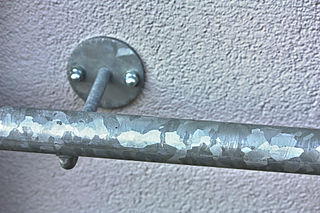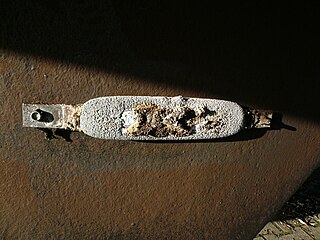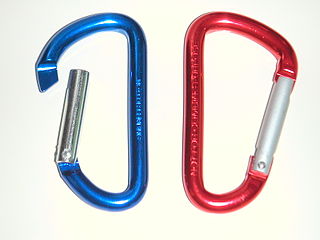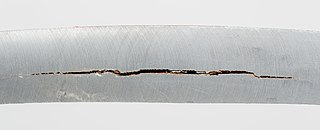Related Research Articles

Galvanization or galvanizing is the process of applying a protective zinc coating to steel or iron, to prevent rusting. The most common method is hot-dip galvanizing, in which the parts are coated by submerging them in a bath of hot, molten zinc.

Metallurgy is a domain of materials science and engineering that studies the physical and chemical behavior of metallic elements, their inter-metallic compounds, and their mixtures, which are known as alloys. Metallurgy encompasses both the science and the technology of metals; that is, the way in which science is applied to the production of metals, and the engineering of metal components used in products for both consumers and manufacturers. Metallurgy is distinct from the craft of metalworking. Metalworking relies on metallurgy in a similar manner to how medicine relies on medical science for technical advancement. A specialist practitioner of metallurgy is known as a metallurgist.

Rust is an iron oxide, a usually reddish-brown oxide formed by the reaction of iron and oxygen in the catalytic presence of water or air moisture. Rust consists of hydrous iron(III) oxides (Fe2O3·nH2O) and iron(III) oxide-hydroxide (FeO(OH), Fe(OH)3), and is typically associated with the corrosion of refined iron.

Corrosion is a natural process that converts a refined metal into a more chemically stable oxide. It is the gradual deterioration of materials by chemical or electrochemical reaction with their environment. Corrosion engineering is the field dedicated to controlling and preventing corrosion.
In physical chemistry and engineering, passivation is coating a material so that it becomes "passive", that is, less readily affected or corroded by the environment. Passivation involves creation of an outer layer of shield material that is applied as a microcoating, created by chemical reaction with the base material, or allowed to build by spontaneous oxidation in the air. As a technique, passivation is the use of a light coat of a protective material, such as metal oxide, to create a shield against corrosion. Passivation of silicon is used during fabrication of microelectronic devices. Undesired passivation of electrodes, called "fouling", increases the circuit resistance so it interferes with some electrochemical applications such as electrocoagulation for wastewater treatment, amperometric chemical sensing, and electrochemical synthesis.

A galvanic anode, or sacrificial anode, is the main component of a galvanic cathodic protection system used to protect buried or submerged metal structures from corrosion.

Anodizing is an electrolytic passivation process used to increase the thickness of the natural oxide layer on the surface of metal parts.

Hydrogen embrittlement (HE), also known as hydrogen-assisted cracking or hydrogen-induced cracking (HIC), is a reduction in the ductility of a metal due to absorbed hydrogen. Hydrogen atoms are small and can permeate solid metals. Once absorbed, hydrogen lowers the stress required for cracks in the metal to initiate and propagate, resulting in embrittlement. Hydrogen embrittlement occurs most notably in steels, as well as in iron, nickel, titanium, cobalt, and their alloys. Copper, aluminium, and stainless steels are less susceptible to hydrogen embrittlement.
Plating is a finishing process in which a metal is deposited on a surface. Plating has been done for hundreds of years; it is also critical for modern technology. Plating is used to decorate objects, for corrosion inhibition, to improve solderability, to harden, to improve wearability, to reduce friction, to improve paint adhesion, to alter conductivity, to improve IR reflectivity, for radiation shielding, and for other purposes. Jewelry typically uses plating to give a silver or gold finish.

Pitting corrosion, or pitting, is a form of extremely localized corrosion that leads to the random creation of small holes in metal. The driving power for pitting corrosion is the depassivation of a small area, which becomes anodic while an unknown but potentially vast area becomes cathodic, leading to very localized galvanic corrosion. The corrosion penetrates the mass of the metal, with a limited diffusion of ions.

Plasma electrolytic oxidation (PEO), also known as electrolytic plasma oxidation (EPO) or microarc oxidation (MAO), is an electrochemical surface treatment process for generating oxide coatings on metals. It is similar to anodizing, but it employs higher potentials, so that discharges occur and the resulting plasma modifies the structure of the oxide layer. This process can be used to grow thick, largely crystalline, oxide coatings on metals such as aluminium, magnesium and titanium. Because they can present high hardness and a continuous barrier, these coatings can offer protection against wear, corrosion or heat as well as electrical insulation.

Chromate conversion coating or alodine coating is a type of conversion coating used to passivate steel, aluminium, zinc, cadmium, copper, silver, titanium, magnesium, and tin alloys. The coating serves as a corrosion inhibitor, as a primer to improve the adherence of paints and adhesives, as a decorative finish, or to preserve electrical conductivity. It also provides some resistance to abrasion and light chemical attack on soft metals.

Electroless nickel-phosphorus plating, also referred to as E-nickel, is a chemical process that deposits an even layer of nickel-phosphorus alloy on the surface of a solid substrate, like metal or plastic. The process involves dipping the substrate in a water solution containing nickel salt and a phosphorus-containing reducing agent, usually a hypophosphite salt. It is the most common version of electroless nickel plating and is often referred by that name. A similar process uses a borohydride reducing agent, yielding a nickel-boron coating instead.
Phosphate conversion coating is a chemical treatment applied to steel parts that creates a thin adhering layer of iron, zinc, or manganese phosphates, to achieve corrosion resistance, lubrication, or as a foundation for subsequent coatings or painting. It is one of the most common types of conversion coating. The process is also called phosphate coating, phosphatization, phosphatizing, or phosphating. It is also known by the trade name Parkerizing, especially when applied to firearms and other military equipment.
Electrogalvanizing is a process in which a layer of zinc is bonded to steel in order to protect against corrosion. The process involves electroplating, running a current of electricity through a saline/zinc solution with a zinc anode and steel conductor. Such Zinc electroplating or Zinc alloy electroplating maintains a dominant position among other electroplating process options, based upon electroplated tonnage per annum. According to the International Zinc Association, more than 5 million tons are used yearly for both hot dip galvanizing and electroplating. The plating of zinc was developed at the beginning of the 20th century. At that time, the electrolyte was cyanide based. A significant innovation occurred in the 1960s, with the introduction of the first acid chloride based electrolyte. The 1980s saw a return to alkaline electrolytes, only this time, without the use of cyanide. The most commonly used electrogalvanized cold rolled steel is SECC, acronym of "Steel, Electrogalvanized, Cold-rolled, Commercial quality". Compared to hot dip galvanizing, electroplated zinc offers these significant advantages:
5083 aluminium alloy is an aluminium–magnesium alloy with magnesium and traces of manganese and chromium. It is highly resistant to attack by seawater and industrial chemicals.
Black oxide or blackening is a conversion coating for ferrous materials, stainless steel, copper and copper based alloys, zinc, powdered metals, and silver solder. It is used to add mild corrosion resistance, for appearance, and to minimize light reflection. To achieve maximal corrosion resistance the black oxide must be impregnated with oil or wax. One of its advantages over other coatings is its minimal buildup.
Sulfidation is a process of installing sulfide ions in a material or molecule. The process is widely used to convert oxides to sulfides but is also related to corrosion and surface modification.

Chemical coloring of metals is the process of changing the color of metal surfaces with different chemical solutions.
References
- 1 2 3 I. Milošev and G. S. Frankel (2018): "Review—Conversion Coatings Based on Zirconium and/or Titanium". Journal of the Electrochemical Society, volume 165, issue 3,pages C127-C144. doi : 10.1149/2.0371803jes
- ↑ ""
- ↑ ""
- ↑ "Fastener Surface Conversion", In: FastenerData.co.uk
- ↑ M. A. Gonzalez-Nunez, C. A. Nunez-Lopez, P. Skeldon, G. E. Thompson, H. Karimzadeh, P. Lyon, and T.E.Wilks (1995): "A non-chromate conversion coating for magnesium alloys and magnesium-based metal matrix composites". Corrosion Science, volume 37, issue 11, pages 1763-1772. doi : 10.1016/0010-938X(95)00078-X
- ↑ A. A. O. Magalhães, I. C. P. Margarita, O. R. Mattos (2004): "Molybdate conversion coatings on zinc surfaces". Journal of Electroanalytical Chemistry, volume 572, issue 2, pages 433-440. doi : 10.1016/j.jelechem.2004.07.016
- ↑ J. A. Wharton, G. D. Wilcox, and K. R Baldwin (1996): "Non-Chromate Conversion Coating Treatments For Electrodeposited Zinc-Nickel Alloys". Transactions of the IMF - The International Journal of Surface Engineering and Coatings, volume 74, issue 6, pages 210-213. doi : 10.1080/00202967.1996.11871128
- ↑ Charles E. Tomlinson (1998): "Chromate-free conversion coatings for metals". US Patent 5759244, filed on 1996-10-09, granted on 1998-06-02, expired on 2016-10-09.
- ↑ Raoling Wang (2018): "Chromium-free aluminum conversion coating agent, aluminum material, and surface conversion coating treatment method". Patent WO2018006270, filed on 2016-07-05, granted on 2018-01-11.
- ↑ Lishi Wang, Tao Feng, Shanwen Yu, Yihang Cheng, Zhixiang Bu and Xinbin Hu (2020): "Fluoride effect on plasma electrolytic oxidation coating formed on Mg-Al alloy in alkaline electrolytes". Materials Research Express, volume 7, issue 1, article 016412. doi : 10.1088/2053-1591/ab60a7
- ↑ Liu Feng, Shan Dayong, Song Yingwei, Liu Xianbin, and Han Enhou (2012): "Highly corrosion-resistant ceramic coating solution prepared through magnesium alloy surface micro-arc oxidation and application thereof". Chinese patent 101994145, filed on 2009-08-19, granted on 2012-05-23.
- ↑ A. P. Rizzato, C. V. Santilli, S. H. Pulcinelli, Y. Messaddeq, and P. Hammer (2004): "XPS Study of the Corrosion Protection of Fluorozirconate Glasses Dip-Coated with SnO2 Transparent Thin Films". Journal of Sol-Gel Science and Technology, volume 32, pages 155–160. doi : 10.1007/s10971-004-5781-9